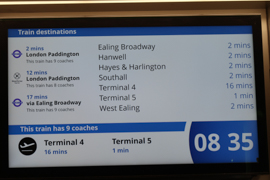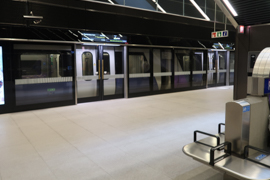Elizabeth Line London
Flyctory.com Pros
- Connects Heathrow and a couple of periphery boroughs with Central London
- Modern trains and nice new train stations
- Significant travel time reduction compared to Piccadilly Line
Flyctory.com Cons
- Neither luggage rack nor toilet
- Current operation with transfers in Paddington and at Liverpool Station
Adding a rail connection for Heathrow Airport, improving the travel options between the West and the East of London – there have indeed be many reasons to build a new rail tunnel across the British capital. Project Crossrail finally turned into Elizabeth Line in late May 2022- a (theoretically) seamless connection. Even though some parts of the project are not working as they are finally supposed to do, I was really flattered when I could ride the Elizabeth Line in mid June 2022 from Heathrow Airport to the city center of London. Here are my thoughts.


Elizabeth Line – Route & Fares
The Elizabeth Line is connecting West and East London. On the West London side, there are the terminal stops Reading and Heathrow Airport (Terminal 4 or 5, all trains pass Terminal 2&3). On the East side of London, there are Shenfield and Abbey Woods. There are also some proposed/planed expansions. Baker Street station is not yet operational. The most prominent possible change is likely a potential re-activation of the former Silvertown station, which would also serve as stop for London City Airport (LCY) and thus connect Heathrow and City Airport directly. The typical frequency is four trains per hours.
Not another Heathrow Express
However, you have to clearly state that the main motivation for the Crossrail project has not been a better transport situation for Heathrow Airport. In fact, the Elizabeth Line was very unpopular at Heathrow during my ride – people either went for the Piccadilly Line or for the faster Heathrow Express. One reason for that may also be that Elizabeth Line is currently interrupted at Paddington station. Trains from the West still arrive in the train station, but then the route continues in the Underground station. You can take a detour on your route and say “Hello” to the Paddington Bear. Similarly, the Shenfield branch of the Elizabeth Line still requires a rail level to Underground level (or viice versa) transfer at Liverpool Street. These issues are scheduled to be eliminated in late 2022.







In general, the Elizabeth Line is operating under the normal Transport for London (TfL) fare system. There is a supplement for using the Elizabeth Line, but the daily cap of your ticket applies to the fares including that supplement, so that if you take the Elizabeth Line in the morning to connect to the city and then do sightseeing across London, you will pay 14.10 GBP (as at the time of writing), regardless if you use Piccadilly Line or Elizabeth Line. There are some very outside stops which do not support Oyster payments.
Elizabeth Line – Rolling Stock
The Elizabeth Line uses the British Rail Class 345 Aventra rail. There are seven and nine carriages version of the train – I just had the longer version during my visit. So far Crossrail runs 70 units, which are built by Bombardier and have a total capacity of 1,500 passengers, thereof 450 seated. I was a bit of surprised about the fact that the whole train, which is roughly 204 meter long (in the long version) only holds four spots for wheelchair passengers. The trains are built for a maximum speed of 90 mph, 145km/h.









Air Conditioning – but no Luggage Rack
The individual wagons do have a different layout. For example, the carriage at the very front of the train I rode to Paddington Station just had bench-alike seats at the walls of the cars, while there were groups of four seats in the middle section of the train. The most striking new feature of the Elizabeth Line compared to Underground trains, though, is that they are air conditioned. The Elizabeth Line features WiFi as long as the train is overground. Unfortunately, I forgot to check when I later had a ride from Tottenham Court Road. I also liked the new displays mounted under the ceiling, which give you good information about connections, the next station and similar essentials.
However, there is one essential which is missing: luggage racks. Compared to the Piccadilly Line trains, which have some priority area to luggage, this makes the Elizabeth Line even worse than that peer. On the one hand, I was absolutely stunned by this fact – on the other hand, this also underlines that the connection to Heathrow is just a subordinate part of the project. The Elizabeth Line trains are equipped in line with the Underground train comfort. This also means that there are no toilets onboard. There are also no power outlets.



















Elizabeth Line – Stations
At Heathrow, the Elizabeth Line operates like a train and is thus sharing the platform with the Heathrow Express. Typically, the Heathrow Express leaves the airport station a few minutes before the new train connection. The information displays are very handy. The Elizabeth Line stations have slightly modified ticket machines, which finally sell the same range of tickets or allow you to top up your Oyster Card.













I also had a look at the new Elizabeth Line station at Tottenham Court Road. The station has a designated entrance – you may, however, also transfer from other lines and then use the already existing gates. Apart from that the station is very modern and the walkways are much wider than in most Underground stations, the most striking feature is that there are walls with opening doors at the platform. This is not new to London visitors, some Jubilee Line stations use the same technology, for example. There are modern and much better displays at the stations, which help you a lot to spot the right train.













I liked the new Paddington Elizabeth Line station even more. The design is very modern and a bit “warmer” than the Tottenham Court Road one. However, the facilities are in general equivalent at both stations. A vast majority of the new train stations are barrier-free.







Heathrow to Central London – Comparison to Alternatives
At my visit in June 2022, the Elizabeth Line was the least popular connection. I guess there are two factors: many tourists do not know about the new connection yet. Additionally, locals already know about the disadvantages. Currently, the key disadvantage is the mandatory transfer at Paddington. If that is solved, a trip between Heathrow Terminal 2&3 station and Tottenham Court Road will reduce to roughly 26 minutes. The equivalent journey by Piccadilly Line takes about double the time. The Elizabeth Line will also lead to a smooth connection to the key National Rail stations at Paddington and Liverpool Street, which may be advantageous (if you ever transferred at London Underground with heavier luggage, you know what I mean…)


It will be interesting how the Elizabeth Line will compare to the Heathrow Express in the future. My limited experience made me feel that the non-stop express service to Paddington Station was significantly more popular than the Elizabeth Line. Of course, the Heathrow Express comes with being designed for air travelers, toilets and a two-class system – whoever needs that on a 15 minute trip. In addition, there are also coach services, especially the National Express bus to Victoria Coach Station.
Elizabeth Line – My View
I have to admit: I expected a bit more. I expected more train feeling and less Underground service. The people living close to the new route already love the Elizabeth Line. The next months will show, if the new offer is also strong enough as a Heathrow transfer alternative. At the moment, the transfer in Paddington is too bothering. The daily price cap on Oyster and contactless payment is a key selling argument for the new peer, though. I definitely struggle with the decision of neither having luggage racks nor toilets on board, though.
“Rides on Rail” Postings
Here is everything about trains, trams and other rail vehicles:

My September 2025 edition of the Food I Had Onboard already starts with some experiences in late August. Again, there is ...

A railroad museum with good reviews, even though I could hardly find any good information on the internet? The Southern ...

Saturday noon rides with German national rail Deutsche Bahn typically give me a good chance for some lounge reviews. While ...

The weather felt ideal for this trip when I visited Innsbruck at the end of October 2024. It was sunny, ...

I try to increase my volume on pure blogging posts, in which I give my personal opinion on certain topics ...

During my May 2025 trip to Istanbul, I did not do too much sightseeing. Quite a lot of stress at ...

My original plan for that Monday was to stay in Nashville and potentially have a look at the Rock n Jock celebrity ...

A late May 2025 trip gave me at least a short opportunity to explore the Turkish city Istanbul. I felt ...

On my trip to Bremen and Stockholm in May 2025, I had quite some time to spend before a Rock of ...

If I would have to name my favorite player I have seen playing for "my" Pittsburgh Penguins, this name would ...

I just had limited time in Indonesia during my October 2024 trip. Nonetheless, I definitely wanted to check out some ...

VR-Yhtymä Oyj Suomen Valtion Rautatiet - or "VR Cooperation Finnish State Railways" is the national railway company of Finland. While I ...

While in Vienna in January 2025, I did a bit of travel nerd things. Among other rail experiences, I was ...

I like public transport of all kinds. Thus, I was really happy that I finally made it to the Pennsylvania ...

After I shared my loyalty portfolio thoughts in March 2024 with you, it is time for an update. Especially the ...

The funicular railway Floibanen (or Fløibanen in Norwegian) is just 848 meter long, but is one of the most well-known ...

I am transportation nerd. Even though there is a certain touch of aviation in that regard on Flyctory.com, I do ...

With my recent mileage run and the trip to the World Floorball Championship Qualifications in Italy, I had quite a ...

While quite a lot of traveling is ahead of me during the next weeks, November and December 2024 was rather ...

has come to an end - and my Best of posting is the one which is "traditionally" concluding the year. The ...

Like I did in 2023, I will kick off my looking back to the year 2024 with some travel facts ...

While most of my lounge reviews deal with airport and airline lounges, I am always flattered to also visit lounge ...

While my 18th edition of the Food I Had Onboard just came with a limited number of trips rather widely ...

I really enjoy riding the Railjet. The type of trains is majorly the backbone of the Austrian high-speed rail network ...

17th October 2023 marked a very special day in the Indonesian and South-East Asian transportation history. The first ever high ...

What's a good way to explore the permanent fun fair and entertainment area in Vienna, the Prater, if you are ...

I did not have that much traveling during the last weeks - but as some major trips are ahead, I ...

Being the only guest in a lounge almost demands me having a lounge review. This happened to me in Dresden ...

Airport trains are a very convenient option to get to an airport. The Arlanda Express in Stockholm, for example, makes ...

After I already introduced you to the Dresden Suspension Cable Railroad (Schwebebahn), it is urgently time to share my other ...

Even though the Grand Central Terminal (or: Grand Central Station) in New York City is a popular touristic attraction, it ...

Oh, I traveled too much the last weeks again. Time for another Food I Had Onboard posting - this time also featuring ...

During a trip to Liege / Luik in Belgium, i took a short detour from a shopping mall to visit ...

67 kilometers alongside the Belgian Coast, serving 67 stations - the Kusttram ("Coastal tram line") is regarded to be the ...

The engine of the train states Se Norge. Ta Toget - or: "See Norway. From the train". Apart from the Flamsbanen, the Bergensbanen, ...

The Öresund Bridge connecting Copenhagen in Denmark and Malmö in Sweden revolutionized did not only revolutionize travel and transport between ...

In my fifteenth edition of my Food I Had Onboard posting series, I have a quhttps://flyctory.com/tag/deutschebahn/ite nice range of flight and ...

In early April 2023, I gave you an insight into my loyalty program strategy for 2023. The posting Thumbs up ...

According to Wikipedia, twelve different railroad lines overall operated from and through Kansas City overall. However, the golden age of ...

During our trip through Tokyo in September 2023, getting around the Japanese capital has been one of the key issues ...

Is it really New Year's Eve already again? The last day of the year? I am posting this one in ...

As you know, I am very interested in iconic public transport systems. Thus, I had to visit the Schwebebahn, the suspension ...

After my eleventh Food I Had Onboard posting majorly concentrated on two Lufthansa First Class legs between Frankfurt (FRA) and ...

TraMy trip in late October / early November 2023 involved a lot of traveling. Once I made it back to ...

If you solely take the ease of traveling as a criteria, I definitely took the wrong choice in regards of ...

The public transport situation of Dusseldorf Airport (DUS) is a bit more complex than it might feel at first sight ...

The Heathrow Express, the Elizabeth Line or the good, old Piccadilly Line - there are many transport options to get ...

After I introduced you to the amazing Florida high speed rail service Brightline already, this post is about about rail ...

Travelling to the very last Rock of Ages shows by the British DLAP production company brought me to Swansea in Wales. The ...

One more Food I had onboard until I have a full set of ten postings. Hope you also enjoy reading ...

The name of the German city of Wuppertal in the Bergische Land region near Cologne is indeed a perfect fit ...

With the introduction of Elizabeth Line, there is now a third option to get from Heathrow Airport (LHR) to the ...

For my trip from Manchester Airport (MAN) to Blackpool in February 2023, I was able to explore a new rail ...

Using public transport all over Germany for 49 Euro? Sounds like the perfect deal, especially if you are a visitor ...

Even though Heidelberg is a tourist magnet for many reasons, the Heidelberger Bergbahnen (Heidelberg Funiculars) are part of it. They offer you ...

The website states that the Nederlands Spoorwegmuseum (also: Het Spoowegmuseum) is the best train station in the Netherlands. In fact, the ...

In January 2023, I took a rail trip hitting all 16 German states in one day. Apart from that geographic ...

Especially when airports are located a little outside the city, airport express trains feel to be the perfect mass transportation ...

A major part of optimizing your travel portfolio is to determine the loyalty program which suits best to you. Thereby, ...

The last legs of the 2023 Weird Al Yankovic European Tour, Rock of Ages shows, the Pittsburgh Penguins and many ...

If you nowadays look at the map of Cyprus, you won't find any rail-driven vehicles. However, the country did have ...

Damn, it is already four years... And it is more than 2,750 postings since then. On 25th February 2018, I ...

Traveling by rail is typically a bit of an extra adventure: the reliability is low, compared to other European countries ...

Wow, it's already half a dozen of episodes. This time, I start my Food I Had Onboard posting with two ...

What a day - on 14th January 2023, I traveled through all 16 German states in a 24 hour train ...

AIthough has just been a day trip, but I just felt it is too long to tell the story of ...

Okay, I give in: this trip is weird. While people typically feel that I am "just" a die hard aviation ...

Even though people typically think that I am an aviation nerd "only", I am in general very interested in any ...

In previous postings, I already introduced you to my excellent travel experience with the Southern Florida high-speed rail provider Brightline ...

The last posting of the year - Best Ones 2022 is introducing you to my best experience last years (as ...

A trip to a Frequent Flyer meeting lead to a post about train rides: Less than two weeks after the ...

Even in the United States, you nowadays run into the green coaches of Flixbus. The company turned out to dominate ...

Especially when I visit large places for Flyctory.com, which give me a lot of memories - and pictures - I ...

Car Free. Carefree - that's the slogan of one of the latest additions to the US public transport network: The company ...

Especially when I visit large places, which demand and deserve a major number of pictures, it may take quite some ...

In between of tour-chasing Weird Al Yankovic in Florida in October 2022 (see my picture posting), I also had the ...

Already the fourth edition of my Food I Had Onboard category. Even though my Covid-19 infection changed quite a lot of ...

While I visited Kansas City in summer 2022, I have been quite amazed that the US-American city drives its own ...

People always feel surprised when I state that I am not just a passionate frequent flyer, but that I also ...

I guess that most Nashville tourists don't even get to know that Music City in fact has a mass public ...

In June 2022, I had the opportunity to have a (for me) rather unique experience as a rail traveler: right ...

During my trip to Canada right after the borders have been opened again in September 2021, I visited a very ...

For my trip to Ambri-Piotta watching local HC Ambri-Piotta at their home ice, Gotthard Arena, I took a seven hour ...

After I got some quite nice feedback about my first Food I Had Onboard posting, I felt to continue this ...

What has started as Stuttgart 21 - the refurbishing of Stuttgart Main Station including changing the main travel direction and putting ...

I have been a bit of puzzled when I arrived in Munich in late January 2022, learning that the Stammstrecke, the ...

Due to its rather hilly geography, the German city of Stuttgart has some quite iconic public transport systems. During a ...

The Lokwelt Freilassing is one of the most famous train museums in Germany. During a trip through Bavaria, I had ...

Yes, I do like flying - but I am also a fan of rail travels. Just to find out how ...

It is time for the final posting of the years, simply named The Best Ones 2021. After looking into my ...

The Tränenpalast ("Palace of Tears") in Berlin is the former border crossing point between East and West Berlin. It is located at ...

Milan-Malpensa Airport (MXP) is the major of the two airports serving the North Italian city. However, there is one issue ...

Sometimes, iconic attractions don't need to be overwhelmingly large to become really worth a visit. The Grazer Schoßbergbahn / Graz Castle Rail, ...

After flying with Porter Airlines from Toronto Billy Bishop Airport (YTZ) to Ottawa, my return trip was on rails. For ...

While I did the "traditional Flyctory.com way" on the outbound trip from Dusseldorf to Krakow and flew LOT Business Class, ...

Yeah, I give in: in amusement parks, I love to do what I call atmospheric rides. Not too quick, but colorful, ...

For years, if I would have wanted to deeply bash the Deutsche Bahn (German Rails), there would have been a simple way ...

Fancying a trip to Venice? If there is no pandemic and the lagoon city is empty, hotel prices in central ...

If you want to travel to The Palm in Dubai, you typically go there by rental car, taxi... Or by ...

I have always been wondering how people from cities like Lockerbie or Lakehurst deal with the faith that their hometown ...

It is one of the the classic trips on Mallorca and something like a must-do for many tourists: taking the ...

After praising my favorite songs of 2020 and the favorite albums and EPs in 2020, the final posting to do ...

Apart from Trenitalia and their Frecciarossa network, there is also NRT (Nuovo Transporto Viaggiatori - "New Travellers Transport"), who are ...

I am not too much in Harry Potter - but therefor, my wife is compensating my lack of knowledge. After ...

After visiting so many German Rail lounges in my life, I was really looking forward how the more exclusive waiting ...

On my Four Contries, Four Trains trip in summer 2020, my rail trip on Day 2 was an absolute highlight of ...

One thousand kilometres to the sea - or vice versa One thousand kilometres to the Alps - was the slogan a new private ...

Also due to the current situation in aviation, I could follow my idea to invest more time in rail travel ...

While - especially for business reasons - trans-European rail connections may still take too much time for daytime transfers, night ...

Heading back home. As said in the Day 3 coverage, I did not expect too much going on on that ...

Being in Milan until the early afternoon, checking out an Italian rail lounge for the first time - and then ...

So excited to travel again and do a proper. I did my first day of the rail rides through Germany, ...

Coming back from London from the (finally cancelled) Country To Country Festival 2020 was the last trip I took before ...

While I so far made an semi-annual look back in time, the "Very Important Postings", I decided something with my ...

The climate discussions during the last months again boosted discussions whether local traffic could not be for free to reduce ...

Pittsburgh is not only the city of the three rivers and countless bridges - on the southern bank of Monongahela ...

If you want to travel from Stockholm's major airport Arlanda to city center, you have multiple options. Undoubtedly, the strongest ...

Not just due to my favorite flight with LATAM from Frankfurt to the Spanish capital, I love being in Madrid ...

Just after I left Chattanooga Airport on Day 3 of my CMA Fest Trip, I went to the Lookout Mountain ...

If you use the Madrid Metro Line 1 between Bilbao and Iglesia, you will likely notice that you pass another ...

Wuppertal in the Bergisches Land region Northeast of Cologne hosts a very special attraction for train and rail enthusiasts: the ...

The 15km long Tenerife tram track system between the harbour area of Santa Cruz and the old capital, San Cristobal ...

The "Jacobite" connecting the Scottish villages of Fort William and Mallaig has always been regarded to be one of the ...
Travel Postings about London
Here are all travel related postings about London:

My American Express Platinum card offers me access to a couple of lounges driven by the credit card provider. After ...

Even though I have a long list of flights to and from London Heathrow Airport (LHR), my history with Terminal ...

Transforming former industrial heritage to a unique and vibrant location of the city - one of the most impressing changes ...

A missed connection or a suitcase not making it - there are numerous ways how things could go wrong while ...

When I visited Atlanta in 2018, I wrote a post Atlanta 1996 - 22 years later, visiting former sites of the ...

My wife and I went for a trip to London over Easter 2025. The hotel we went for was the ...

Time to go home. The last somehow two days of my Six US States and Nashville trip majorly featured my ...

After I just gave you the preview of this trip so far, my road trip around Nashville was finally starting ...

Immersive arts exhibitions are becoming more and more popular. I introduced you to the ARTE Museum in Dubai or the ...

In 1974, the former church St Mark's on North Audley Street in London has been deconsecrated. Nowadays, the centrally located place becomes ...

Immersive art experiences are becoming more and more popular. First of all, the technology to drive them and the creators ...

One of the most legendary soccer events in my (always a bit broken) 1. FC Köln (Cologne) sports heart was ...

Even though London is one of the foreign cities I visit most frequently, I haven't shared some travel experience with ...

After I had a stay at the Novotel in the area right before Covid-19 broke out, I haven't been staying ...

Opting for American Airlines over British Airways when flying from London-Heathrow (LHR) to the United States has a key advantage: ...

In order to cover the Jenn Bostic show in London in February 2024, I was looking for a hotel in ...

Since 2007, the Hyde Park Winter Wonderland in London has become a more and more growing Christmas and winter tradition ...

Terminal 3 of Heathrow Airport (LHR) is something like the safe haven for British Airways Executive Club (BAEC) status customers ...

Being in Crawley near Gatwick Airport (LGW) by rental car gave me the opportunity to visit the Gatwick Aviation Museum ...

When you think about water and river cruises in London, you likely think about the boat trips on the River ...

Having a musical night in London in August 2023, I needed an affordable overnight with good connections to the London ...

The Heathrow Express, the Elizabeth Line or the good, old Piccadilly Line - there are many transport options to get ...

A Rock of Ages musical trip to Peterborough near Cambridge in February 2023 required me to rent a car. For this trip, ...

Travelling to the very last Rock of Ages shows by the British DLAP production company brought me to Swansea in Wales. The ...

Tennis is back on lawn these days - and this also means that professional tennis players and tennis fans are ...

With the introduction of Elizabeth Line, there is now a third option to get from Heathrow Airport (LHR) to the ...

I have been to quite a lot of Premier Inn hotels in recent times. In Germany as well as in ...

The area around Prince Consort Road in South Kensington, London, is a treat for music lovers. It hosts one of the key ...

After I made you familiar with Swingers, the "Crazy Golf" provider in the heart of London recently, I just felt ...

It is hard to argue against that the Sofitel London Heathrow is the most convenient option when you need a ...

Leadenhall Market is one of the most beautiful markets in London. The covered market in Central London has been initially ...

Visiting London in late November 2022, my wife and I were aiming to do some things outside the Christmas tourism ...

Harry Potter has turned a fictive wizard into a huge franchise. Right next to the place you can spend roughly ...

Before I headed to Portsmourth for some Rock of Ages shows in Southern England, I had a night at the Premer ...

I personally love mini golf. For me, it is a great way to relax while trying to identify the right ...

The 7th November 2022 is one of these days I will hardly forget so quickly. In a Weird Al fan ...

People always feel surprised when I state that I am not just a passionate frequent flyer, but that I also ...

Being able to have a look into the Courtyard by Marriott London City Airport was the cause of a rather ...

In June 2022, I had the opportunity to have a (for me) rather unique experience as a rail traveler: right ...

In June 2022, I had a night at the Premier Inn London Paddington Basin. The booking was quite short-noticed after ...

For a Saturday evening show at The O2 in London, I have been looking for a reasonably priced hotel with ...

Quite some hectic a few weeks before I actually visited my favorite musical Rock of Ages again. After the show has been ...

The last entry of my (multi-day) trip reports is typically a bit of boring. Getting to the airport, flying back ...

First day of my Weird Al trip in April 2022. I was initially even thinking about merging it with Day ...

Even though I do have a couple of airport reviews on Flyctory.com, I so far missed a lot of the ...

Renting a car at London Heathrow Airport typically leads to a shuttle bus ride from one of the terminals to ...

During the later phases of the Covid-19 lock-downs in Germany, I had the idea to that posting. Maybe just because ...

Due to their high incidences on the delta variant of Covid-19, the United Kingdom is still / again in the ...

Right next to Waterloo Station, the Merlin Entertainments Ltd. drives quite a bunch of places for the London tourist heart ...

2.5 million visitors per day - Madame Tussauds is definitely one of the most popular touristic destinations of London. The ...

It used to be the Millennium Wheel, turned to be the British Airways London Eye and now it is the ...

Before the pandemic limitations, One New Change Mall in London has been a really popular place. First of all, it ...

The limited travel intensity during summer and fall 2020 lead to some interesting budget travel opportunities. During a trip to ...

I assue that there is hardly any travel guide for London, which is mentioning the Namco Funscape as an important ...

You might find this statement multiple times within my December 2020 postings - but A Christmas Carol by Charles Dickens is ...

It is still uncertain when there will be regular touristic travel between the United Kingdom or Europe and North America ...

I am not too much in Harry Potter - but therefor, my wife is compensating my lack of knowledge. After ...

I would say that the opening of the Hilton Garden Inn London Heathrow Terminal 2/3 has been one of the ...

As I delayed some reviews after I saw that Covid-19 will have a significant impact on us and our travel ...

I could not react any more when finally the C2C Country to Country in London 2020 had been cancelled. Thus, ...

A view over London from a skyscraper for free, located in a beautiful garden-alike area - and all this even ...

With British Airways' decision to move all short-distance connections including the one to Cologne/Bonn airport to Heathrow, I unfortunately will ...

The Mithraeum in London is maybe one of the hidden gems of the British capital. During exvacation works in London ...

With nearly 310 meters, The Shard close to the South Bank of River Thames is the tallest building of the United ...

For the transatlantic flights of my February 2020 trip to California supporting the Pittsburgh Penguins, I had a personal Star ...

Visiting Brett Eldredge's and Lauren Jenkins' final show of their January 2020 European tour (here are reviews of their Amsterdam ...

Four ice hockey matches, Rock of Ages #32 in Hollywood, two new airlines and many more impressions - this trip ...

Day 1 of my trip to the Penguins. The travel days to the US are typically not too thrilling. Leaving ...

Since my recent trips to Singapore and Taiwan latest I know that the true hero of Asian pop culture is ...

The De Havilland company is a huge name in the aviation history, especially regarding British aviation history. Close to the ...

In early January 2020, I had a British Airways Mileage Run, flying from Cologne/Bonn to Gatwick and then spending a ...

During a November 2019 stay in London, I opted for the DoubleTree right at Victoria Station. Especially as we were ...

For just one month, Nintendo installed a Pokemon Center pop-up store in London, the so-called Pokemon Center London. I have ...

The place is so tiny and mousy that there is a huge potential to miss it: if you are exploring ...

If I would turn Flyctory.com into a food blog, I am sure it would be a terrible fail. Nevertheless, there ...

Thousands of people pass Hatton Cross every day without ever getting an impression of the area. The Piccadilly Line London ...

Premier Inn is a branch of budget hotels which is especially active in the United Kingdom. There are, however, also ...

After I stayed at the ibis Styles London ExCeL during the Country 2 Country 2018 already, I chose the hotel ...

In May 2019, I had another weekend trip to London. As my wife and I flew into London City Airport, ...

As part of a company event in Paris, I was able to see the Tutankhamun exhibition. Until the completion of ...

A picturesque city center and a huge variety of superb museums - Oxford is one of the key tourist destination ...

I chose the ibis Canning Town just North of the River Thames as my stay for the Country 2 Country ...

London's three major airports, Heathrow, Gatwick and Standsted, are all some sort of a mess, when you in fact want ...

Before I visited Danielle Hope's amazing show at the Zedel near Piccadilly Circus, I decided to go for another Stadium ...

My first steps around O2 Arena in London during the Country 2 Country Festival 2019 were not motivated by country ...

After my 2018 debut at the London Country 2 Country and the first-time German event in Berlin the weekend before, ...

When Germany intensified their offensive efforts during World War II, Winston Churchill decided to built a bunker in Central London ...

Due to a Eurowings flight cancellation on a London daytrip in early January, I got stuck at Stansted Airport. The ...

While Air Belgium is doing their very own route from Brussels-Charleroi to Hong Kong, they are currently also supporting the ...

British Airways flight BA 1 has always been on my bucket list. The very special connection between London and New ...

Country 2 Country, short: C2C, has established to be the largest country music festival in Europe. In fact, it is ...




























































































































































































































































































